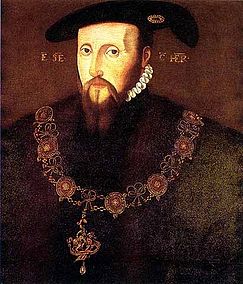
In 1549, the position of Edward Seymour, Duke of Somerset, was becoming precarious, as rebellions throughout the country were matched by dissention within the King’s council. The rebellions were spurred by expectations that the year’s harvest would be as poor as that of 1548 – though the truth was that the entire decade had been a period of acute price inflation. People questioned Somerset’s policies, especially his support of religious reform and agrarian enclosures – and his wars with Scotland. They also mistrusted a man who would send his own brother to the block (though goodness knows Tom Seymour deserved it – for one, the man broke into the King’s apartments in the middle of the night and shot his dog! Check out the “Thomas Seymour” tags for posts I’ve written about those incidents!). Meanwhile John Dudley, Earl of Warwick, was rabble-rousing within the King’s Council.
So a beleaguered Somerset tried a desperation move. He took possession of the King’s person, and withdrew for safety from Hampton Court to the fortified and easily-defended Windsor Castle. Somerset had not taken into account the fact that the King had grown into a twelve year-old boy who did not appreciate being treated like a chess piece. Edward was outraged by Somerset’s behavior. “Me thinks I am in prison,” he wrote in his Chronicle. (This is really the greatest treasure, a diary written at times in the third person that gives a fascinating glimpse into his thoughts).
The Council reacted on October 8 by proclaiming the Protector a traitor, publishing details of his government mismanagement. By October 11, the game was over. They sent guards to rescue the King and arrest Somerset and his wife. Edward summarized the charges against Somerset in his Chronicle: “ambition, vainglory, entering into rash wars in mine youth, negligent looking on Newhaven, enriching himself of my treasure, following his own opinion, and doing all by his own authority, etc.” In the end, Somerset pleaded guilty to 29 counts of treason.
Still, Somerset escaped this trap. He apologized and was released from the Tower. John Dudley, Earl of Warwick, took over as President of the Council; he and the King accepted Somerset’s contrition, and even allowed him to return to the Council and Privy Chamber. As a mark of reconciliation, Warwick even married his heir John to Somerset’s daughter Anne. But that wasn’t enough for the ambitious Somerset. He started amassing political sympathizers and plotting to remove Warwick from the scene. It didn’t work. On October 11, 1551, Warwick was elevated to the Dukedom of Northumberland. Five days later, Edward Seymour was arrested for “contemplating” the Lord President’s arrest and execution. That was it for Somerset. He was executed on January 22, 1552.
Sources:
As always, Wikipedia – Edward Seymour, 1st Duke of Somerset provides a good understanding of the subject. For more in-depth analysis, Albert Frederick Pollard offers a short (23 pages) biography entitled Edward Seymour, Duke of Somerset
***
If you like my posts, you’ll love my books! My Seymour Saga trilogy tells the gripping story of the short-lived dynasty that shaped the Tudor Era. Jane the Quene skews romantic, The Path to Somerset is pure Game of Thrones (without the dragons), and The Boy King is a noir coming-of-age. Get them now through Amazon, Barnes & Noble, Kobo, and Apple, or even your local independent bookstore!

(PS Already read them? Did you love them? Then please review them – even just a stars rating! It makes a huge difference in helping new readers find them and would mean the world to me!)

Reblogged this on tudors & other histories and commented:
Great article. This is almost reminiscent of what another uncle did with his royal nephew. I need to read that biography of Pollard. I like reading everything Tudor and I am glad the Seymours are getting more attention.
Another uncle did this? I have to read more about that!
Yep, Richard III or Duke of Gloucester. It is before the Tudors but it is very similar because the two basically told their royal nephews the same ‘hey dude we have to move you for your safety, you can’t trust in these evil people’. Of course, Edward Seymour had no intention of deposing his nephew, just control him. Whereas Richard … that’s less uncertain. I think he wanted to take control of Edward V because he believed he was much more suited to be Regent than the Woodvilles who wanted absolute power as well; but when things got bad he saw one option out of this and that was deposing him and crown himself King.
You are so right! The situations are very much alike if Richard wasn’t the one to kill the princes, very different if he was. Either way, I see Richard as having sent Edward to the Tower “for his protection” while Somerset dragged Edward to Windsor like he was taking a hostage!
Lol so true. At least Richard had put up of the guise ‘hey I am protecting you’ while Edward just took him. No wonder the nobles got more upset! They already had their lists of grievances, and there was a lot of envy, against Edward Seymour but this topped it.